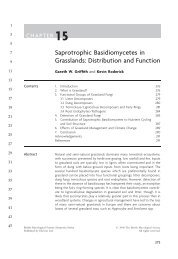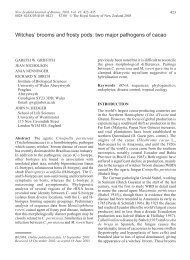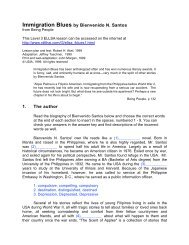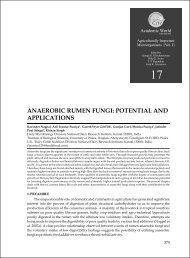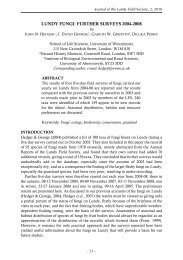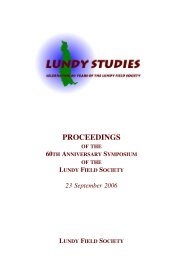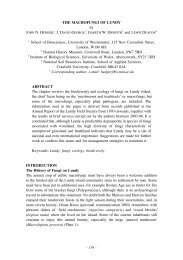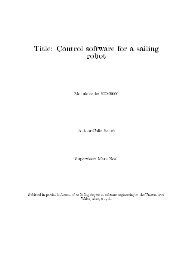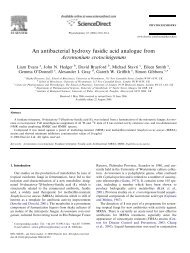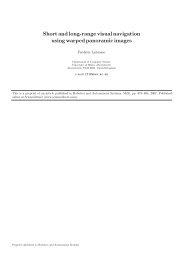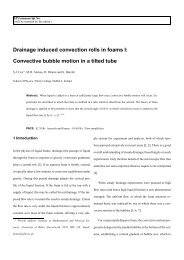Chytridiomycota - Users Site
Chytridiomycota - Users Site
Chytridiomycota - Users Site
Create successful ePaper yourself
Turn your PDF publications into a flip-book with our unique Google optimized e-Paper software.
868 MYCOLOGIA<br />
tate kinetosomatis per zoosporum radiant circum<br />
nucleus, flagellum obturamentum nullum. Generare<br />
nonsexus cum zoosporae, generare sexus ad conjiungare<br />
planogametum, orbis vita cum meiosis sporae.<br />
Typus: Blastocladia Reinsch 1878<br />
Zoospore with a single flagellum, side-body complex,<br />
nuclear cap of membrane-bounded ribosomes,<br />
cone-shaped nucleus that terminates near the kinetosome,<br />
microtubules radiate anteriorly from the<br />
proximal end of the kinetosome around the nucleus,<br />
zoospore flagellum lacks electron-opaque plug in<br />
transition zone. Asexual reproduction with zoospores,<br />
sexual reproduction through fusion of planogametes,<br />
life cycle with sporic meiosis.<br />
Type: Blastocladia Reinsch 1878<br />
Blastocladiomycetes cl. nov. T. James. Description as<br />
for Blastocladiomycota.<br />
Reinsch described Blastocladia in 1878, and Petersen<br />
(1910) erected the family Blastocladiaceae to<br />
accommodate this single genus, classifying it in the<br />
class Oomycetes. Kanouse (1927) first used the order<br />
name, Blastocladiales (which she credited to Petersen),<br />
and included in it the single family with<br />
Allomyces and Gonapodya (now removed). Fitzpatrick<br />
(1930) placed the Blastocladiales in class Phycomycetes,<br />
a classification Sparrow (1960) followed. Alexopoulos<br />
(1966) separated fungi into eight classes, one<br />
of which was class Chytridiomycetes, including Blastocladiales.<br />
This placement for the Blastocladiales was<br />
retained as Chytridiomycetes was elevated to the<br />
phylum <strong>Chytridiomycota</strong> (not validly published, no<br />
Latin diagnosis; p 15 in von Arx 1967, Margulis et al<br />
1989). <strong>Chytridiomycota</strong> will be validated when the<br />
phylogeny is more clearly resolved.<br />
Although Tehler (1988) used Blastocladiomycota<br />
as a division (phylum) name, the taxon was not validly<br />
published because he did not provide or refer to<br />
a Latin description or diagnosis or explain the basis of<br />
or rationale for this name (Article 36.1, Greuter et al<br />
2000). Consequently it is nomen nudum and furthermore<br />
the group that Tehler (1988) circumscribed<br />
with this name is not monophyletic. Thus we have<br />
used Blastocladiomycota as a phylum for a monophyletic<br />
clade (Clade 3), validated the phylum name<br />
with a Latin description and have designated a type. A<br />
potentially competing phylum name, Allomycota<br />
(Cavalier-Smith 1981), is invalid because Cavalier-<br />
Smith did not include a Latin diagnosis. We may<br />
select the phylum name Blastocladiomycota however<br />
because the principle of priority is not mandatory<br />
above the rank of family (Article 11.1, 11.9). Cavalier-<br />
Smith (1998) eventually validated class Allomycetes<br />
with Latin; however this validation is moot to our<br />
Mycologia myco-98-06-18.3d 4/1/07 13:38:52 868 Cust # 06-083R<br />
selection because a name does not have priority<br />
outside its own rank (Article 11.2). As we have<br />
described the Blastocladiomycota, it is a natural<br />
group separate from the more heterogeneous phylum<br />
Archemycota (Cavalier-Smith 1998).<br />
Clade 4. Olpidium brassicae.—Olpidium brassicae<br />
unexpectedly grouped among the polyphyletic Zygomycota<br />
and with the nonzoosporic fungi. O. brassicae<br />
currently is assigned to the Spizellomycetales (Barr<br />
1980), although this placement was considered<br />
tenuous (Barr 2001). Few ecological and morphological<br />
features unite O. brassicae and Zygomycota; O.<br />
brassicae is a root pathogen of cucurbits, whereas most<br />
members of the Zygomycota II lineage (FIG. 2) are<br />
associated with animals. The zoospore of O. brassicae<br />
contains a unique combination of features, coneshaped<br />
striated rhizoplast, gamma-like particles and<br />
rough endoplasmic reticulum (Lange and Olson<br />
1976). These ultrastructural features as well as<br />
holocarpic, endobiotic sporangia had suggested a relationship<br />
between Olpidium and Rozella (Held 1975),<br />
but Olpidium differs from Rozella in that sporangia of<br />
the former develop a cell wall inside the host<br />
cytoplasm while sporangia of Rozella do not and<br />
instead use the host’s cell wall (Held 1981). Further<br />
data will be needed to determine the exact phylogenetic<br />
position of O. brassicae and whether it shares<br />
a common ancestor with the majority of terrestrial<br />
fungi. We predict that Caulochytrium protostelioides<br />
with a similar zoosporic ultrastructure and aerially<br />
produced sporangia (Powell 1981) also will be<br />
a member of this currently monotypic clade.<br />
Toward a phylogenetic classification.—The paraphyly<br />
of the <strong>Chytridiomycota</strong> requires that its current<br />
circumscription be redefined to produce a phylogenetic<br />
classification system. Placing all flagellated true<br />
Fungi into one phylum does not reflect shared<br />
ancestry of these fungi because the flagellum was<br />
a character possessed by the common ancestor of all<br />
Fungi (i.e. it is a pleisiomorphic character. Furthermore<br />
the absence of a flagellated state (as in<br />
Hyaloraphidium curvatum) should not prevent the<br />
inclusion of nonzoosporic fungi among natural<br />
groups of Chytridiomycetes. The phylogeny (FIG. 2)<br />
suggests the existence of at least four major lineages<br />
of chytrids. The distinction of Blastocladiomycota<br />
from other chytrids is clear on the basis of life cycle<br />
(Sparrow 1960), ultrastructural characters (FIG. 3)<br />
and multiple molecular phylogenetic studies using<br />
rDNA (James et al 2000, this study), RPB1 (Tanabe et<br />
al 2004), RPB2 (T.Y. James unpublished) and whole<br />
mitochondrial genome sequencing (Seif et al 2005).<br />
The exact placement of the holocarpic parasites<br />
Rozella and Olpidium, formerly included in the



